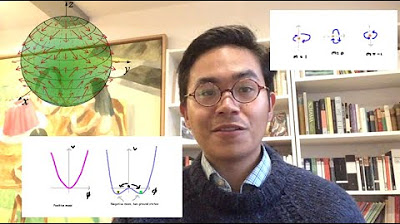The Unity of Physics: From New Materials to Fundamental Laws of Nature by David Tong, Cambridge
TLDRDavid Tong from the University of Cambridge delivers an insightful lecture on the unity of physics, exploring the surprising connections between different areas of physics such as quantum field theory and condensed matter physics. He discusses the fundamental laws of nature, the standard model of particle physics, and the concept of universality, emphasizing the inevitability of certain mathematical equations in describing physical phenomena across various scales. Tong also highlights the importance of Kenneth Wilson's work on the renormalization group, which has significantly influenced theoretical physics by providing a framework to understand these universal behaviors.
Takeaways
- 🎓 David Tong, a distinguished speaker from the University of Cambridge, has an impressive academic background with positions at Columbia, MIT, Stanford, and universities in India and Korea.
- 🏆 David Tong has received numerous accolades, including the Simon's Investigator Award and the Royal Society Wolfson Research Merit Award, for his contributions to theoretical physics.
- 🌌 Tong's research spans a variety of topics such as solitons in quantum field theory and particle vortex duality, reflecting a broad and deep expertise in theoretical physics.
- 📚 The lecture aims to provide a broader perspective on physics, emphasizing the surprising connections between different areas of physics that share underlying explanations.
- 🔬 The talk introduces two main paths in physics: applying fundamental laws to understand the world (e.g., through material science and technology) and delving deeper into the unknown aspects of the universe (e.g., high-energy physics).
- 🧠 The concept of 'universality' in physics is highlighted, where the same fundamental equations describe different phenomena, suggesting an underlying unity in the physical laws of the universe.
- 🔗 The surprising connection between high-energy physics and condensed matter physics is underscored, where deep questions in both fields lead to the same problems and solutions.
- 📈 Kenneth Wilson's work is presented as pivotal, introducing the renormalization group framework that has had a profound impact on theoretical physics, influencing how physicists think about the world.
- 🔍 Wilson's insights revealed a hierarchy and compartmentalization in the universe, where smaller scales affect larger ones but not vice versa, and details on one scale are often irrelevant at larger scales.
- 🌐 The inevitability of certain equations in physics is discussed, indicating that regardless of the specifics of the universe's fundamental laws, certain equations will naturally emerge due to universality.
- 🤔 The lecture concludes by highlighting the ongoing quest to understand complex phenomena like the critical point in phase transitions, which remain challenging despite decades of effort.
Q & A
Who is the speaker of the lecture and what is his background?
-The speaker is David Tong from the University of Cambridge. He has previously held positions at Columbia University, MIT, and Stanford University, and has also worked in India and Korea.
What are some of the awards David Tong has received?
-David Tong has received the prestigious Simon's Investigator Award, the Royal Society Wolfson Research Merit Award, and several other research and teaching prizes.
What is the main theme of David Tong's lecture?
-The main theme of the lecture is the unity of physics, exploring the connections between different areas of physics and the fundamental laws of nature.
What are the two paths in physics that David Tong describes?
-The two paths in physics described by David Tong are: one focused on applying the fundamental laws of physics to understand the world around us and develop new technologies, and the other delving deeper into the unknown to understand mysteries such as dark matter and the origins of the universe.
What is the significance of the Standard Model of particle physics?
-The Standard Model of particle physics is the quantum mechanical description of a few particles interacting through a few forces. It is currently our best understanding of the fundamental laws of nature at the particle level.
What is the surprising connection David Tong mentions between high energy physics and condensed matter physics?
-The surprising connection is that when asking deep questions in either high energy physics or condensed matter physics, one ends up struggling with the same problems and finding the same solutions, despite the different motivations and applications of these fields.
What is the historical significance of Newton's equation of gravity?
-Newton's equation of gravity is historically significant as it was the first equation that allowed for the explanation of a wide range of natural phenomena, such as planetary orbits, tides, and the falling of apples, all through a single, simple equation.
Why are the equations for gravity and electric force the same?
-The reason why the equations for gravity and electric force are the same is still a subject of wonder and investigation. It is an example of a surprising connection in physics that suggests an underlying unity in the universe's fundamental laws.
What is the Meissner effect in superconductors?
-The Meissner effect is a phenomenon where a superconductor expels magnetic fields from its interior. This effect is a result of the superconductor giving mass to the photon, which then repels magnetic fields.
What is the role of the Higgs boson in particle physics?
-The Higgs boson is responsible for giving mass to certain particles, such as the W and Z bosons, through a process known as the Higgs mechanism. This is crucial for understanding the weak nuclear force and the properties of elementary particles.
What is the Dirac equation and why is it significant?
-The Dirac equation is a fundamental equation in physics that combines quantum mechanics and special relativity to describe the behavior of electrons. It is significant because it led to the prediction of antimatter and is applicable to various particles in the universe.
What is a topological insulator and how is the Dirac equation related to it?
-A topological insulator is a material that is an insulator in its bulk but has conducting surface states. The Dirac equation describes the behavior of these surface states, revealing a surprising connection between particle physics and material science.
Who is Kenneth Wilson and what is his contribution to physics?
-Kenneth Wilson is a physicist known for his work on the renormalization group, which provides a framework for understanding how physical systems behave at different scales. His insights have had a profound impact on various areas of physics, including particle physics and condensed matter physics.
What does the renormalization group tell us about the universe?
-The renormalization group tells us about the hierarchical structure of the universe and the flow of information between different scales. It also reveals the concept of universality, where certain phenomena are inevitable and independent of the specific details of the system.
What is the significance of the number 0.11008 in physics?
-The number 0.11008 is significant in physics as it appears in the critical behavior of various systems, such as the heat capacity at the critical point of phase transitions. It is an example of a universal number that emerges from the underlying equations of physics, regardless of the specific system.
How does the concept of universality relate to the Dirac equation?
-The concept of universality relates to the Dirac equation in that the equation describes a wide range of particles and phenomena in physics, from electrons to quarks, and from particle colliders to topological insulators. It is a special equation that appears in different areas of physics.
What are the implications of Wilson's work for the study of physics?
-Wilson's work implies that there are certain fundamental equations in physics that are universal and apply across different systems and scales. This understanding guides physicists to focus on these special equations and the phenomena they describe, leading to a deeper comprehension of the physical world.
Outlines
🎓 Introduction to Theoretical Physics and Its Unity
David Tong, a distinguished speaker from the University of Cambridge, sets the stage for a lecture on the unity of physics. He outlines his intention to explore the interconnectedness of various areas within physics, challenging the conventional approach of focusing on a single topic. Tong's lecture promises to delve into the broader picture of theoretical physics, emphasizing surprising connections between seemingly unrelated topics and aiming to impart insights into the nature of scientific discovery and the universe.
🔬 The Dual Paths of Physics: Fundamental Research and Applied Science
The speaker introduces two main paths in physics: one that delves deeper into the fundamental laws of nature, such as high-energy physics, and another that applies these laws to understand and innovate in the world around us, exemplified by condensed matter physics. Tong illustrates the orthogonal nature of these paths while hinting at the underlying unity that emerges when exploring deep questions in either domain, suggesting a shared destination in the quest for understanding.
🔗 Unveiling the Unexpected Connections in Physics
Tong presents the central theme of his lecture: the surprising connections between different areas of physics. He provides historical examples where different questions lead to the same underlying answers, such as the universality of the inverse-square law in gravity and electricity. The speaker aims to demonstrate the magical and counterintuitive nature of these connections, setting the stage for a deeper exploration of their implications.
📚 Historical Perspectives on the Unity of Physical Laws
The lecture takes a historical detour to discuss the origins of key physical laws, such as Coulomb's law, and highlights the often overlooked contributions of scientists like Joseph Priestley and John Robison. Tong emphasizes the importance of understanding the history of physics to appreciate the unity and interconnectedness of its principles, as well as the surprising similarities in equations describing different forces.
🌌 The Universal Equations of Nature: From Superconductors to Particle Physics
Tong explores the concept of universality in physics, using the example of superconductivity and its connection to the Higgs mechanism in particle physics. He explains how the same equations describe seemingly unrelated phenomena, such as the mass of photons in superconductors and the mass of W and Z bosons in the standard model. This section of the lecture reinforces the idea that fundamental equations recur across different areas of physics.
🧠 The Legacy of Paul Dirac and the Versatility of His Equation
The speaker discusses the impact of Paul Dirac's equation, which not only described the electron but also predicted the existence of antimatter. Tong explains how this equation has been found to be applicable in various contexts, including the study of topological insulators, demonstrating the far-reaching influence of Dirac's work and the recurring theme of universal equations in physics.
🔬 The Revolutionary Insights of Kenneth Wilson and the Renormalization Group
Tong introduces Kenneth Wilson and his development of the renormalization group, a framework that has had a profound impact on theoretical physics. Despite Wilson's work being highly technical and mathematical, Tong attempts to convey its significance, emphasizing how it provides a way to understand the inevitability of certain equations appearing across different scales and phenomena in the universe.
🌐 The Hierarchical Structure of the Universe and the Flow of Information
The lecture delves into Wilson's first lesson, which is the hierarchical organization of the universe based on scale. Tong explains that small-scale phenomena influence large-scale phenomena, but not the other way around, using humor and an xkcd cartoon to illustrate the point. This concept is central to understanding the reductionist approach in science and the challenges of scaling from fundamental laws to complex systems.
📈 Compartmentalization and Universality in Physics
Wilson's second lesson is explored, focusing on the compartmentalization of the universe and the concept of universality. Tong discusses how details at one scale are often irrelevant at larger scales, leading to the emergence of universal behaviors that are independent of the underlying details. This idea is exemplified by the critical point of phase transitions, where certain properties are shared across different substances.
🔍 The Inevitability of Certain Mathematical Equations in Physics
Tong concludes with Wilson's third lesson, which is the inevitability of certain equations in physics. These equations are special and arise repeatedly in different areas of physics, regardless of the specific details of the systems being studied. The lecture emphasizes the importance of identifying and studying these equations, as they are the key to understanding the fundamental behaviors of the universe.
🤔 The Challenge of Understanding Complex Phenomena: Boiling Water and Critical Points
The speaker highlights the challenge of understanding seemingly simple phenomena like boiling water, which involves complex equations that are not yet fully understood. Tong describes the critical point of water as an example of a phase transition that exhibits universal behavior, and he discusses the ongoing efforts to find the underlying mathematics that explains these phenomena.
🌟 The Quest for Understanding the Fundamental Equations of the Universe
In the final part of the lecture, Tong reflects on the gathering of scientists from various disciplines to tackle the challenging problems set forth by Wilson in the 1970s. He emphasizes the importance of combining different intuitions and approaches to make progress in understanding the fundamental equations that govern the universe, concluding with an optimistic outlook on the potential for future discoveries.
Mindmap
Keywords
💡Theoretical Physics
💡Standard Model
💡Quantum Mechanics
💡General Relativity
💡High Energy Physics
💡Condensed Matter Physics
💡Superconductivity
💡Renormalization Group
💡Universality
💡Dirac Equation
💡Topological Insulators
Highlights
David Tong from the University of Cambridge discusses the unity of physics, exploring connections between different areas of physics.
Tong's research spans solitons in quantum field theory, particle vortex duality, and more, reflecting a broad approach to theoretical physics.
He emphasizes the surprising connections between physics topics that seem unrelated but share underlying explanations.
Tong outlines the two paths in physics: applying fundamental laws to understand the world and delving deeper into the unknown.
High-energy physics and condensed matter physics are used as examples to illustrate the convergence of different paths in physics.
The talk highlights the idea that deep questions in physics often lead to the same problems and solutions, regardless of the path taken.
Tong shares historical anecdotes about the development of physics, emphasizing the confusion and gradual emergence of clarity.
Examples of universal equations in physics, such as Newton's law of gravity and Coulomb's law for electric charge, are discussed.
The unification of different forces in nature through the same mathematical equations is presented as a miraculous aspect of physics.
Tong explains the phenomenon of superconductivity and its connection to the concept of giving mass to photons.
The discovery of the Higgs boson and its role in giving mass to particles is related to the equations of superconductivity.
Dirac's equation, which combines quantum mechanics and special relativity, is highlighted for its beauty and depth.
The prediction of antimatter from Dirac's equation and its experimental confirmation is noted as a significant achievement.
Topological insulators and the unexpected appearance of the Dirac equation in material science are discussed.
Kenneth Wilson's work on the renormalization group and its impact on understanding universality in physics is explained.
Wilson's framework is described as a way to address many problems in physics and to understand the inevitability of certain equations.
The concept of universality, where certain equations keep appearing in different areas of physics, is explored.
Tong concludes with the aspiration to understand challenging problems in physics, such as the equations behind phase transitions.
Transcripts
Browse More Related Video
5.0 / 5 (0 votes)
Thanks for rating:





